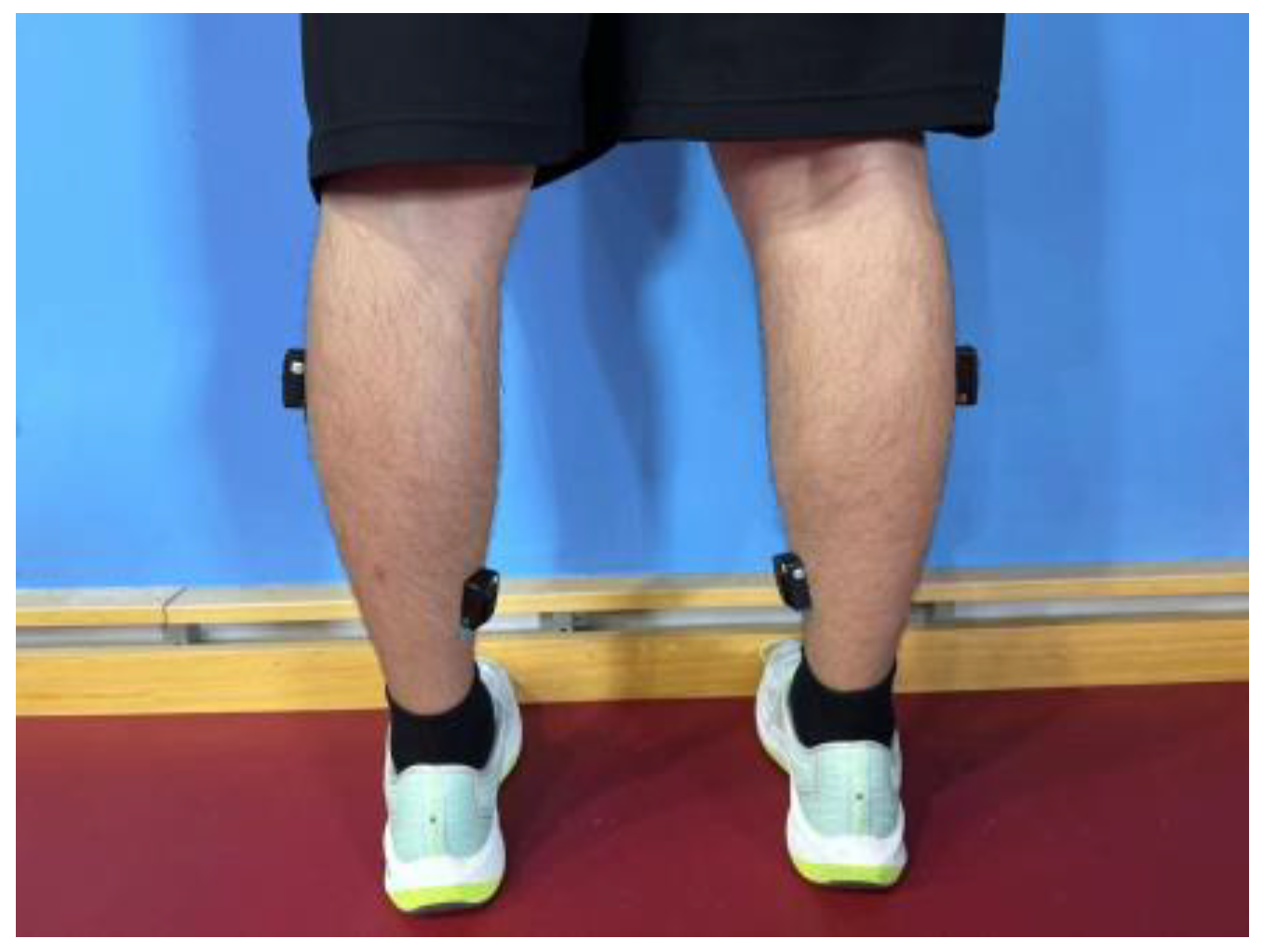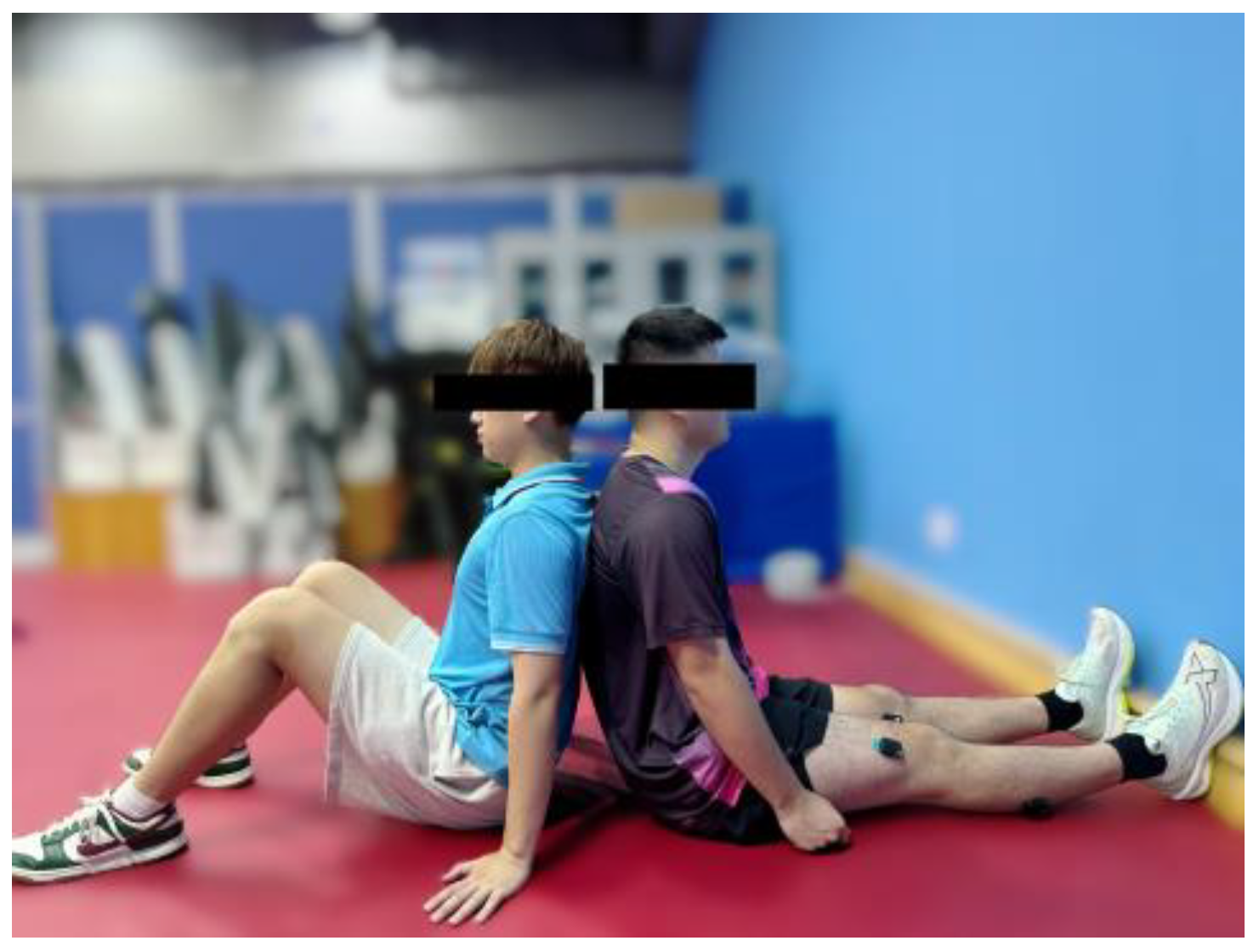Effects of Fatigue on Ankle Flexor Activity and Ground Reaction Forces in Elite Table Tennis Players
Abstract
:1. Introduction
- (1)
- There will be a reduction in ankle flexor activity and a decline in heel height from the ground following fatigue in athletes.
- (2)
- Reduced plantarflexion due to fatigue will negatively affect the generation of ground reaction forces (GRFs).
2. Materials and Methods
2.1. Subjects
2.2. Measurement Items
2.2.1. Kinematics
2.2.2. Electromyography
2.2.3. Force
2.2.4. Vertical Jump Touch Device and Serving Robot
2.3. Experimental Design
2.4. Experimental Procedure
2.4.1. Warm-Up and Vertical Jump Test
2.4.2. Maximal Voluntary Contraction (MVC) Test
2.4.3. Fatigue Task
2.5. Data Processing
2.5.1. Coordinate Systems
2.5.2. Motion Phase Definition
2.5.3. Heel Height
2.5.4. Muscle Activity Level
2.5.5. Maximal Ground Reaction Force (GRF)
2.6. Statistical Analysis
3. Results
3.1. Muscle Activity Levels
3.2. Heel Height
3.3. Maximal Ground Reaction Force (GRF)
4. Discussion
4.1. Muscle Activity of Plantarflexion Decreased after Fatigue
4.2. Co-Contraction Index Increased from Pre to Post Fatigue
5. Conclusions
Author Contributions
Funding
Institutional Review Board Statement
Informed Consent Statement
Data Availability Statement
Acknowledgments
Conflicts of Interest
References
- Bańkosz, Z.; Winiarski, S. The kinematics of table tennis racquet: Differences between topspin strokes. J. Sports Med. Phys. Fit. 2017, 57, 202–213. [Google Scholar] [CrossRef] [PubMed]
- Le Mansec, Y.; Pageaux, B.; Nordez, A.; Dorel, S.; Jubeau, M. Mental fatigue alters the speed and the accuracy of the ball in table tennis. J. Sports Sci. 2018, 36, 2751–2759. [Google Scholar] [CrossRef] [PubMed]
- Kondrič, M.; Matković, B.; Furjan-Mandić, G.; Hadžić, V.; Dervišević, E. Injuries in racket sports among Slovenian players. Coll. Antropol. 2011, 35, 413–417. [Google Scholar] [PubMed]
- Bańkosz, Z.; Winiarski, S. Correlations between angular velocities in selected joints and velocity of table tennis racket during topspin forehand and backhand. J. Sports Sci. Med. 2018, 17, 330. [Google Scholar] [PubMed]
- Iino, Y.; Kojima, T. Kinetics of the upper limb during table tennis topspin forehands in advanced and intermediate players. Sports Biomech. 2011, 10, 361–377. [Google Scholar] [CrossRef]
- Zhang, L.; Cai, X. Shoulder joint characteristics of advantage arm of table tennis players. J. Shandong Inst. Phys. Educ. Sports 2009, 25, 69–72. [Google Scholar]
- Zhang, L.; Jiang, H.; Shang, X.; Ge, H.; Li, G.; Liu, G. Rehabilitation Training for Rotator Cuff Injury in Elite Table Tennis Players: A Case Report. Chin. J. Sports Med. 2011, 30, 752–754. [Google Scholar]
- Marcora, S.M.; Staiano, W.; Manning, V. Mental fatigue impairs physical performance in humans. J. Appl. Physiol. 2009, 106, 857–864. [Google Scholar] [CrossRef]
- Gandevia, S.C. Spinal and supraspinal factors in human muscle fatigue. Physiol. Rev. 2001, 81, 1725–1789. [Google Scholar] [CrossRef]
- Martin, K.; Thompson, K.G.; Keegan, R.; Ball, N.; Rattray, B. Mental fatigue does not affect maximal anaerobic exercise performance. Eur. J. Appl. Physiol. 2015, 115, 715–725. [Google Scholar] [CrossRef]
- Pageaux, B.; Marcora, S.M.; Rozand, V.; Lepers, R. Mental fatigue induced by prolonged self-regulation does not exacerbate central fatigue during subsequent whole-body endurance exercise. Front. Hum. Neurosci. 2015, 9, 67. [Google Scholar] [CrossRef] [PubMed]
- Habay, J.; Proost, M.; De Wachter, J.; Díaz-García, J.; De Pauw, K.; Meeusen, R.; Van Cutsem, J.; Roelands, B. Mental fatigue-associated decrease in table tennis performance: Is there an electrophysiological signature? Int. J. Environ. Res. Public Health 2021, 18, 12906. [Google Scholar] [CrossRef] [PubMed]
- Aune, T.K.; Ingvaldsen, R.; Ettema, G. Effect of physical fatigue on motor control at different skill levels. Percept. Mot. Ski. 2008, 106, 371–386. [Google Scholar] [CrossRef]
- van Leeuwen, A.M.; van Dieën, J.H.; Daffertshofer, A.; Bruijn, S.M. Ankle muscles drive mediolateral center of pressure control to ensure stable steady state gait. Sci. Rep. 2021, 11, 21481. [Google Scholar] [CrossRef]
- De Ridder, R.; Willems, T.; Vanrenterghem, J.; Robinson, M.A.; Palmans, T.; Roosen, P. Multi-segment foot landing kinematics in subjects with chronic ankle instability. Clin. Biomech. 2015, 30, 585–592. [Google Scholar] [CrossRef]
- Di Nardo, F.; Mengarelli, A.; Maranesi, E.; Burattini, L.; Fioretti, S. Assessment of the ankle muscle co-contraction during normal gait: A surface electromyography study. J. Electromyogr. Kinesiol. 2015, 25, 347–354. [Google Scholar] [CrossRef]
- Boozari, S.; Jamshidi, A.A.; Sanjari, M.A.; Jafari, H. Effect of functional fatigue on vertical ground-reaction force in individuals with flat feet. J. Sport Rehabil. 2013, 22, 177–183. [Google Scholar] [CrossRef] [PubMed]
- Gerlach, K.E.; White, S.C.; Burton, H.W.; Dorn, J.M.; Leddy, J.J.; Horvath, P.J. Kinetic changes with fatigue and relationship to injury in female runners. Med. Sci. Sports Exerc. 2005, 37, 657–663. [Google Scholar] [CrossRef]
- Stegeman, D.; Hermens, H. Standards for surface electromyography: The European project Surface EMG for non-invasive assessment of muscles (SENIAM). Enschede Roessingh Res. Dev. 2007, 10, 108–112. [Google Scholar]
- Le Mansec, Y.; Dorel, S.; Hug, F.; Jubeau, M. Lower limb muscle activity during table tennis strokes. Sports Biomech. 2018, 17, 442–452. [Google Scholar] [CrossRef]
- PONGBOT M-ONE. Available online: https://www.futuremind.com.cn/ (accessed on 20 August 2020).
- Konrad, P. The abc of emg. A Pract. Introd. Kinesiol. Electromyogr. 2005, 1, 30–35. [Google Scholar]
- Maffiuletti, N.A.; Aagaard, P.; Blazevich, A.J.; Folland, J.; Tillin, N.; Duchateau, J. Rate of force development: Physiological and methodological considerations. Eur. J. Appl. Physiol. 2016, 116, 1091–1116. [Google Scholar] [CrossRef] [PubMed]
- Zhang, X.; Fu, W.; Xia, R.; Liu, Y. Effects of Exercise-Induced Fatigue on Joint Mechanics, Stiffness, and Energy Absorption in Lower Extremity during Landings. China Sport Sci. Technol. 2017, 37, 48–55. [Google Scholar]
- Tsai, L.-C.; Sigward, S.M.; Pollard, C.D.; Fletcher, M.J.; Powers, C.M. Effects of fatigue and recovery on knee mechanics during side-step cutting. Med. Sci. Sports Exerc. 2009, 41, 1952–1957. [Google Scholar] [CrossRef] [PubMed]
- Borg, G. Borg’s Perceived Exertion and Pain Scales; Human Kinetics: Champaign, IL, USA, 1998. [Google Scholar]
- He, Y.; Lyu, X.; Sun, D.; Baker, J.S.; Gu, Y. The kinematic analysis of the lower limb during topspin forehand loop between different level table tennis athletes. PeerJ 2021, 9, e10841. [Google Scholar] [CrossRef]
- Merletti, R.; Conte, L.R.L. Surface EMG signal processing during isometric contractions. J. Electromyogr. Kinesiol. 1997, 7, 241–250. [Google Scholar] [CrossRef]
- Cifrek, M.; Tonković, S.; Medved, V. Measurement and analysis of surface myoelectric signals during fatigued cyclic dynamic contractions. Measurement 2000, 27, 85–92. [Google Scholar] [CrossRef]
- Enoka, R.M.; Duchateau, J. Translating fatigue to human performance. Med. Sci. Sports Exerc. 2016, 48, 2228. [Google Scholar] [CrossRef]
- Hornery, D.J.; Farrow, D.; Mujika, I.; Young, W. Fatigue in tennis: Mechanisms of fatigue and effect on performance. Sports Med. 2007, 37, 199–212. [Google Scholar] [CrossRef]
- Cifrek, M.; Medved, V.; Tonković, S.; Ostojić, S. Surface EMG based muscle fatigue evaluation in biomechanics. Clin. Biomech. 2009, 24, 327–340. [Google Scholar] [CrossRef]
- Hosseini, E.; Daneshjoo, A.; Sahebozamani, M.; Behm, D. The effects of fatigue on knee kinematics during unanticipated change of direction in adolescent girl athletes: A comparison between dominant and non-dominant legs. Sports Biomech. 2024, 23, 1219–1228. [Google Scholar] [CrossRef] [PubMed]
- Brown, A.M.; Zifchock, R.A.; Hillstrom, H.J. The effects of limb dominance and fatigue on running biomechanics. Gait Posture 2014, 39, 915–919. [Google Scholar] [CrossRef] [PubMed]
- Gu, Y.; Yu, C.; Shao, S.; Baker, J.S. Effects of table tennis multi-ball training on dynamic posture control. PeerJ 2019, 6, e6262. [Google Scholar] [CrossRef] [PubMed]
- Lam, W.-K.; Fan, J.-X.; Zheng, Y.; Lee, W.C.-C. Joint and plantar loading in table tennis topspin forehand with different footwork. Eur. J. Sport Sci. 2019, 19, 471–479. [Google Scholar] [CrossRef]
- Junge, A.; Engebretsen, L.; Mountjoy, M.L.; Alonso, J.M.; Renström, P.A.; Aubry, M.J.; Dvorak, J. Sports injuries during the summer Olympic Games 2008. Am. J. Sports Med. 2009, 37, 2165–2172. [Google Scholar] [CrossRef] [PubMed]
- Guan, Y.; Bredin, S.; Jiang, Q.; Taunton, J.; Li, Y.; Wu, N.; Wu, L.; Warburton, D. The effect of fatigue on asymmetry between lower limbs in functional performances in elite child taekwondo athletes. J. Orthop. Surg. Res. 2021, 16, 33. [Google Scholar] [CrossRef]
- Afonso, J.; Peña, J.; Sá, M.; Virgile, A.; García-de-Alcaraz, A.; Bishop, C. Why sports should embrace bilateral asymmetry: A narrative review. Symmetry 2022, 14, 1993. [Google Scholar] [CrossRef]
- Boden, B.P.; Dean, G.S.; Feagin, J.A.; Garrett, W.E. Mechanisms of Anterior Cruciate Ligament Injury; SLACK Incorporated Thorofare: West Deptford, NJ, USA, 2000; Volume 23, pp. 573–578. [Google Scholar]
- Sperlich, B.; Koehler, K.; Holmberg, H.-C.; Zinner, C.; Mester, J. Table tennis: Cardiorespiratory and metabolic analysis of match and exercise in elite junior national players. Int. J. Sports Physiol. Perform. 2011, 6, 234–242. [Google Scholar] [CrossRef]
- Grandou, C.; Wallace, L.; Impellizzeri, F.M.; Allen, N.G.; Coutts, A.J. Overtraining in resistance exercise: An exploratory systematic review and methodological appraisal of the literature. Sports Med. 2020, 50, 815–828. [Google Scholar] [CrossRef]
- Symons, I.K.; Bruce, L.; Main, L.C. Impact of overtraining on cognitive function in endurance athletes: A systematic review. Sports Med.-Open 2023, 9, 69. [Google Scholar] [CrossRef]
- Yang, P.; Xu, R.; Le, Y. Factors influencing sports performance: A multi-dimensional analysis of coaching quality, athlete well-being, training intensity, and nutrition with self-efficacy mediation and cultural values moderation. Heliyon 2024, 10, e36646. [Google Scholar] [CrossRef] [PubMed]
- Seeley, M.K.; Funk, M.D.; Denning, W.M.; Hager, R.L.; Hopkins, J.T. Tennis forehand kinematics change as post-impact ball speed is altered. Sports Biomech. 2011, 10, 415–426. [Google Scholar] [CrossRef]
- Iino, Y.; Yoshioka, S.; Fukashiro, S. Uncontrolled manifold analysis of joint angle variability during table tennis forehand. Hum. Mov. Sci. 2017, 56, 98–108. [Google Scholar] [CrossRef] [PubMed]
- Forestier, N.; Nougier, V. The effects of muscular fatigue on the coordination of a multijoint movement in human. Neurosci. Lett. 1998, 252, 187–190. [Google Scholar] [CrossRef] [PubMed]
- Rota, S.; Morel, B.; Saboul, D.; Rogowski, I.; Hautier, C. Influence of fatigue on upper limb muscle activity and performance in tennis. J. Electromyogr. Kinesiol. 2014, 24, 90–97. [Google Scholar] [CrossRef]
- Fenter, B.; Marzilli, T.S.; Wang, Y.T.; Dong, X.N. Effects of a Three-Set Tennis match on knee kinematics and leg muscle activation during the tennis serve. Percept. Mot. Ski. 2017, 124, 214–232. [Google Scholar] [CrossRef]









| Leg | GRF Vectors | Pre-Fatigue | Post-Fatigue | p Value |
|---|---|---|---|---|
| Left | Fx | 0.57 ± 0.24 | 0.84 ± 0.10 | 0.002 * |
| Fy | 1.69 ± 1.18 | 1.39 ± 0.92 | 0.495 | |
| Fz | 81.45 ± 0.19 | 81.17 ± 0.98 | 0.340 | |
| Right | Fx | 1.21 ± 0.76 | 1.15 ± 0.73 | 0.845 |
| Fy | 4.86 ± 0.81 | 4.59 ± 1.02 | 0.480 | |
| Fz | 124.23 ± 2.89 | 124.10 ± 3.50 | 0.976 |
Disclaimer/Publisher’s Note: The statements, opinions and data contained in all publications are solely those of the individual author(s) and contributor(s) and not of MDPI and/or the editor(s). MDPI and/or the editor(s) disclaim responsibility for any injury to people or property resulting from any ideas, methods, instructions or products referred to in the content. |
© 2024 by the authors. Licensee MDPI, Basel, Switzerland. This article is an open access article distributed under the terms and conditions of the Creative Commons Attribution (CC BY) license (https://creativecommons.org/licenses/by/4.0/).
Share and Cite
Lu, Y.; Wang, J.; Ren, Y.; Ren, J. Effects of Fatigue on Ankle Flexor Activity and Ground Reaction Forces in Elite Table Tennis Players. Sensors 2024, 24, 6521. https://doi.org/10.3390/s24206521
Lu Y, Wang J, Ren Y, Ren J. Effects of Fatigue on Ankle Flexor Activity and Ground Reaction Forces in Elite Table Tennis Players. Sensors. 2024; 24(20):6521. https://doi.org/10.3390/s24206521
Chicago/Turabian StyleLu, Yunfei, Jun Wang, Yuanshi Ren, and Jie Ren. 2024. "Effects of Fatigue on Ankle Flexor Activity and Ground Reaction Forces in Elite Table Tennis Players" Sensors 24, no. 20: 6521. https://doi.org/10.3390/s24206521






